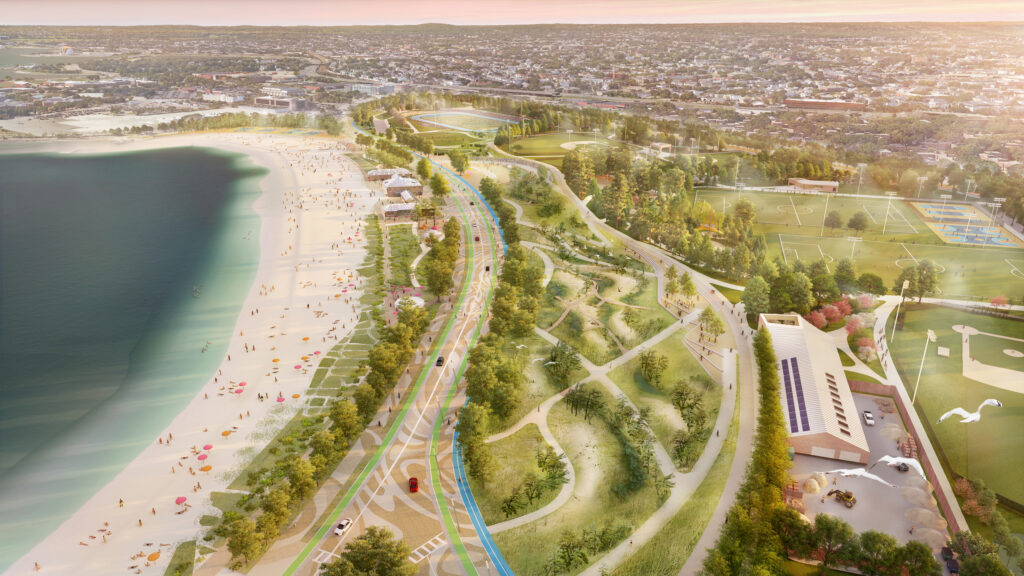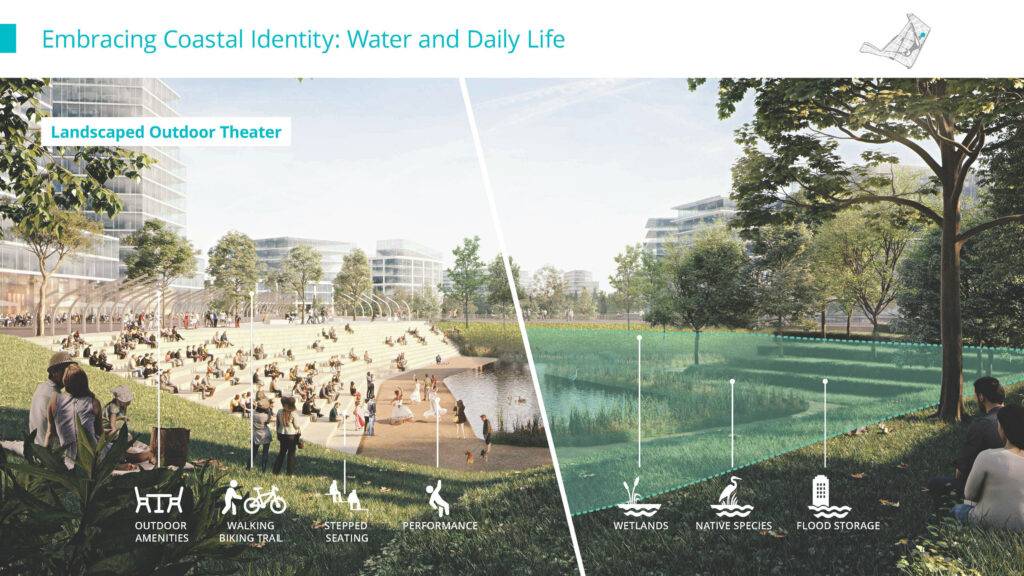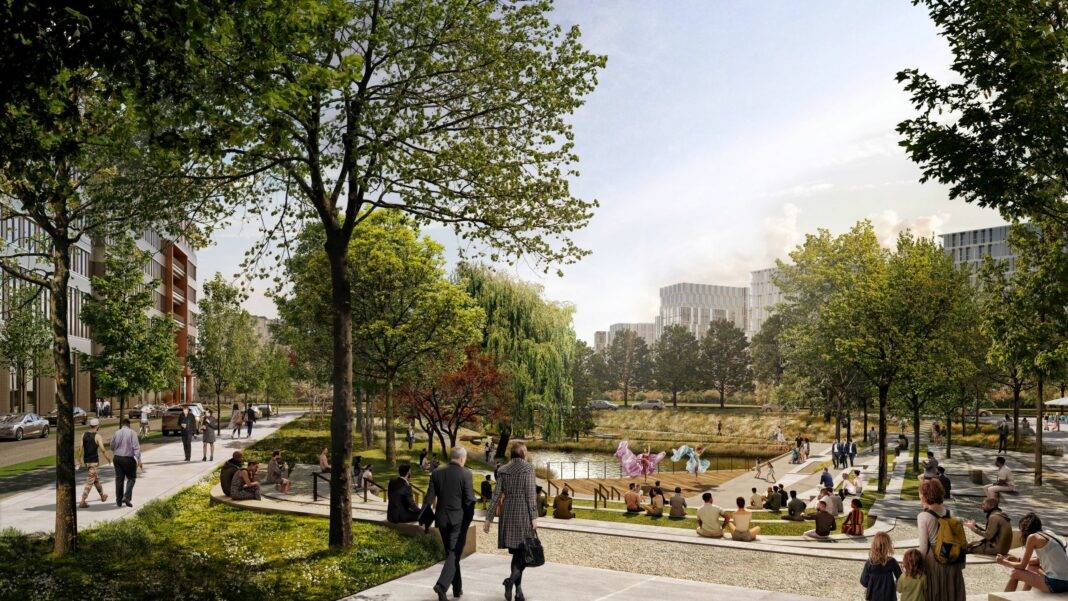Boston-based Stoss Landscape Urbanism balances nature, people, and rising waters.
The environment is not limited to woods and mountains and wilderness. Most of us spend a small fraction of our lives in “nature,” and the vast majority in cities and towns — the “built environment.” The built environment is how most people interact with (and impact) the environment every day. And the best landscape architects account for and respect nature, bringing the natural environment into the built one, including the need to adapt these spaces for climate change.
“We’re trying to layer back different experiences in nature, and how those are made accessible in the city,” says Chris Reed, founding director of Stoss Landscape Urbanism. “It doesn’t have to be about removing yourself from the environment you’re in, but it’s made more accessible in the place that you’re at.” Chris notes when designers and planners talk about natural spaces in urban environments, “it’s about sustainability, it’s about resilience, it’s about ecological functioning, it’s about biodiversity. But for the person on the street, it may be about … really lush habitat for more bird and plant species than are typically encountered in the city.” He says his work is also about “trying to give access to those kinds of experiences.”
Stoss Landscape Urbanism designs large and small landscape architecture all over the country, with offices in Boston and LA. Chris is also a professor of landscape architecture at the Harvard University Graduate School of Design, so Boston and its environs feature much of his company’s work.
Two major Stoss projects that are underway are Suffolk Downs and Moakley Park, both showing the importance of balancing competing needs in a densely populated environment. “They’re twins in some ways,” says Chris. “They’re both major projects. Suffolk Downs is probably the biggest single contiguous urban development site in the city. Whereas, Moakley Park is both the largest harborfront park in the city, and the renovation represents Boston’s largest investment in open space in over a century, since Olmsted was doing the Emerald Necklace,” Boston’s seven-mile string of parks stretching from the Common to Franklin Park in Roxbury.
Moakley Park

The renovation at Moakley Park in South Boston is in part to make the park more resilient to sea-level rise, but also to make the park more useful to the community.
The project to revitalize the park’s mix of sports fields, playgrounds, and other amenities should break ground in 2024.
And water is an important issue for this waterfront park. “Both [projects] started, among other things, from a motivation to deal with sea-level rise, climate change,” according to Chris. “Turns out on both projects, we started learning a lot — you always do — and it’s not just that sea-level rise is an issue, and will be an issue.” At Moakley Park, “one of the first things people told us was, ‘That’s fine. We get it. That’s thirty years off, and right now we can’t use the fields because they flood now.’”
Urban heat was another issue that cropped up at Moakley Park. Urban areas with a lot of pavement and few trees heat up in the summer faster than more leafy places, a phenomenon known as the urban heat island effect. Chris says the public input revealed “the need for cooling and cooling stations, mostly from folks who were living right across the street in public housing.” This shifted the way his team thought about the project. ”It was also really helpful to get this incredible diversity of opinion on what should go in the park.”
When designing public spaces, public engagement is critical. The city collected 22,000 pieces of public input, Chris says. “We find that diversity of opinion, and frankly diversity of not just what people want but what they need, to be incredibly helpful to the project. One of the things we tend to do is to make sure within public environments we’re putting people from different backgrounds, with different interests, with different needs, with different desires, into the same room. So that they’re hearing from each other what the competing needs are.”
The demands on a rebuilt Moakley Park are high, so Chris values hearing from all kinds of voices. “There were moments that were contentious and everybody wanted more,” says Chris. “The total number of desired programs and activities was far more numerous than what anybody suspected … So I find those processes really helpful. It really helped to inform what I think will become a really incredible, diverse and active and energetic park. I think that kind of programming process means that more people will want to come here from different backgrounds, which will just make for an incredibly thriving place. So there’s a piece of that that we find energizing and incredibly informative.”
Suffolk Downs
The 161-acre site of the former horse track straddling East Boston and Revere, Suffolk Downs is owned by HYM Investments and will become a mixed-use site with commercial office, retail, housing, and open space. Construction of some buildings is underway. Stoss, with extensive experience in coastal resilience, worked with the developer to design the open space, including wetlands, marshes, and a system of interlocking open spaces that will channel water during high tides and storms. “We’re providing that flood protection, we’re adapting, but we’re doing it in a way which actually is contributing ecological, environmental value to the site,” Chris says.
Suffolk Downs, being developed privately, still gathered its own public input, requiring sign off from the community and the City of Boston. While the process is managed differently, Chris says, “At the end of the day, it’s not that different. The community’s still interested in a project like that. What is the public access gonna be? What are the community benefits? What’s the open space gonna be like? How can we inform that open space? How is it useful to people who live there now in addition to people who will be moving in?”

“Both [projects] exist within interestingly diverse neighborhoods; diverse in terms of income, race, and ethnicity,” Chris notes. “Moakley Park tries to very explicitly take on issues of racial and social equity; providing better access to public spaces, etc. But the developers of Suffolk Downs have also tried to address issues of inequity through full public access, affordable housing, etc.”
As our climate changes, our cities and towns will need to change, too. And landscape architects like those at Stoss will need to keep balancing the needs of changing environments and dynamic communities. Good urban design, says Chris, “can have a positive influence, a small influence on climate change itself. But certainly in the way that we adapt to climate change, those projects are really important.”
To learn more, visit the Stoss Landscape Urbanism website.



